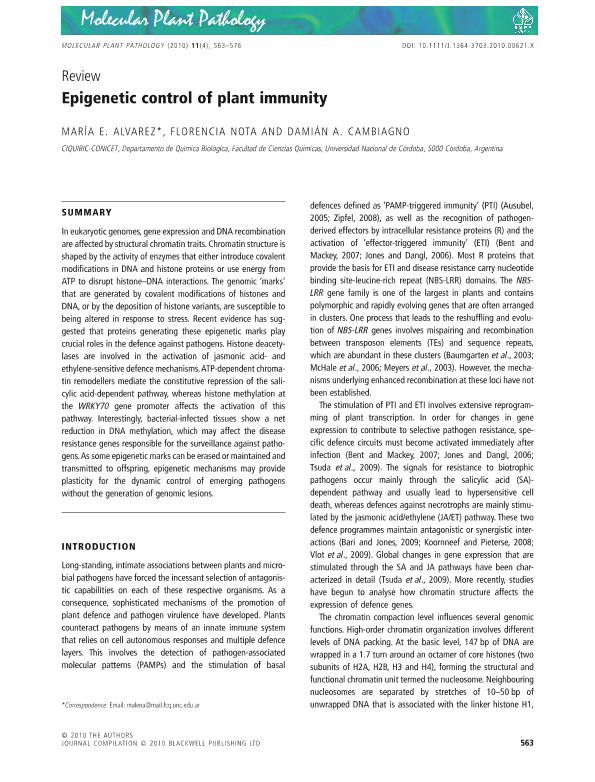Artículo
Epigenetic control of plant immunity
Fecha de publicación:
01/06/2010
Editorial:
Wiley Blackwell Publishing, Inc
Revista:
Molecular Plant Pathology
ISSN:
1464-6722
e-ISSN:
1364-3703
Idioma:
Inglés
Tipo de recurso:
Artículo publicado
Clasificación temática:
Resumen
In eukaryotic genomes, gene expression and DNA recombination are affected by structural chromatin traits. Chromatin structure is shaped by the activity of enzymes that either introduce covalent modifications in DNA and histone proteins or use energy from ATP to disrupt histoneDNA interactions. The genomic "marks" that are generated by covalent modifications of histones and DNA, or by the deposition of histone variants, are susceptible to being altered in response to stress. Recent evidence has suggested that proteins generating these epigenetic marks play crucial roles in the defence against pathogens. Histone deacetylases are involved in the activation of jasmonic acid- and ethylene-sensitive defence mechanisms. ATP-dependent chromatin remodellers mediate the constitutive repression of the salicylic acid-dependent pathway, whereas histone methylation at the gene promoter affects the activation of this pathway. Interestingly, bacterial-infected tissues show a net reduction in DNA methylation, which may affect the disease resistance genes responsible for the surveillance against pathogens. As some epigenetic marks can be erased or maintained and transmitted to offspring, epigenetic mechanisms may provide plasticity for the dynamic control of emerging pathogens without the generation of genomic lesions.
Palabras clave:
EPIGENETIC
,
ARABIDOPSIS
,
PATHOGENESIS
Archivos asociados
Licencia
Identificadores
Colecciones
Articulos(CIQUIBIC)
Articulos de CENTRO DE INVEST.EN QCA.BIOL.DE CORDOBA (P)
Articulos de CENTRO DE INVEST.EN QCA.BIOL.DE CORDOBA (P)
Citación
Alvarez, Maria Elena; Nota, María Florencia; Cambiagno, Damián Alejandro; Epigenetic control of plant immunity; Wiley Blackwell Publishing, Inc; Molecular Plant Pathology; 11; 4; 1-6-2010; 563-576
Compartir
Altmétricas




